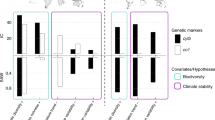Abstract
Cadena et al.1 question our conclusion that species diversity can positively influence speciation rate on the basis of their analysis of a data set for West Indian land birds, in which an additional variable is added — lineage age. Here we clarify our hypothesis and show why their system is not suitable for testing whether species diversity can drive speciation.
Similar content being viewed by others
Main
Cadena et al. find that lineage age is correlated with species diversity and per cent endemism. However, as they point out, a fourth variable, island area, is also strongly collinear with species diversity and endemism, and so with lineage age. A similar collinearity between island area and species diversity occurs for one of our four analyses, Hawaiian plants, and we recognized the difficulty of disentangling the effect of these two variables. For West Indian land birds, island area is likely to be the causative agent for the observed levels of endemism, perhaps because bigger islands contain older species assemblages that have had more time to accumulate endemics, as Cadena et al. suggest. Hence, if island area and not species diversity is driving diversification of the avifauna of the West Indies — a likely scenario, given its non-equilibrium state with an imbalance between colonization and extinction2 — Cadena et al. risk comparing apples with oranges.
MacArthur and Wilson's classic theory3 is traditionally interpreted in terms of colonization and extinction, but we pointed out that it also makes predictions for speciation4. Even in the simplest scenario of anagenetic speciation only, the theory of island biogeography predicts that, all other things being equal, islands with more species will have a greater proportion of endemics (Fig. 1a). Here the proportion of endemics does provide an index of speciation (and extinction) rate, contrary to the assertion of Cadena et al.1. Similarly, all other things being equal, larger islands are expected to have a smaller proportion of endemics than smaller islands (Fig. 1b). This discrepancy with the results of Cadena et al. is consistent with the non-equilibrium nature of the West Indian avifauna, where colonization does not yet seem to be balanced by extinction2. Our predictions are expected for the systems we used4, where there is a balance between colonization, speciation and extinction (as seen in Canary Island arthropods5, where island area and age are not positively related to the proportion of endemics).
a, The number of species on an island is a balance between the arrival of colonizing species to an island (black lines) and extinction (red line)3. For two islands of the same size but with differing colonization rates, the island receiving more colonists is expected to contain more species. As the same factors that influence extinction rate also influence speciation rate4, the model can predict speciation rate: the island with more species should have a greater proportion of endemics because of a comparatively higher speciation rate. b, For two islands with a similar colonization rate but having different numbers of species because of their different sizes, the smaller island (red line) should have a greater proportion of endemic species than the larger island (blue line).
Cadena et al. also point out that predictions regarding lineage age made from the theory of island biogeography can be tested by molecular phylogenetics. However, lineage age is better determined using age estimates for the most recent common ancestor of monophyletic groups within islands (see ref. 6, for example). This provides a conservative minimum age estimate to allow for extinctions between the most recent common ancestor of island species and that connecting an island clade to a sister lineage on another land mass7. Extinctions between the nodes that involve taxa outside the island will inflate the true population age. Hence, the lineage age estimation of Cadena et al. may be misleading, particularly in view of taxon-cycling theory as applied to the West Indian avifauna, which supports a relationship between endemicity and sister lineage extinction8.
We agree that our theory of how species richness drives diversification may be less important in systems that are not under equilibrium conditions. But the analysis by Cadena et al. does little to bring into question our conclusion that species diversity may be an important driver of speciation.
References
Cadena, C. D., Ricklefs, R. E., Jiménez, I. & Bermingham, E. Nature 438, doi:10.1038/nature04308 (2005).
Ricklefs, R. E. & Bermingham, E. Science 294, 1522–1524 (2001).
MacArthur, R. H. & Wilson, E. O. The Theory of Island Biogeography (Princeton Univ. Press, Princeton, New Jersey, 1967).
Emerson, B. C. & Kolm, N. Nature 434, 1015–1017 (2005).
Emerson, B. C. & Oromí, P. Evolution 59, 586–598 (2005).
Emerson, B. C. Anim. Biodiv. Cons. 26, 9–20 (2003).
Emerson, B. C. Mol. Ecol. 11, 951–966 (2002).
Ricklefs, R. E. & Bermingham, E. Ostrich 70, 49–59 (1999).
Author information
Authors and Affiliations
Corresponding author
Rights and permissions
About this article
Cite this article
Emerson, B., Kolm, N. Is speciation driven by species diversity? (Reply). Nature 438, E2 (2005). https://doi.org/10.1038/nature04309
Published:
Issue Date:
DOI: https://doi.org/10.1038/nature04309
This article is cited by
-
Inverting the null-hypothesis of speciation: a marine snail perspective
Evolutionary Ecology (2009)
Comments
By submitting a comment you agree to abide by our Terms and Community Guidelines. If you find something abusive or that does not comply with our terms or guidelines please flag it as inappropriate.




